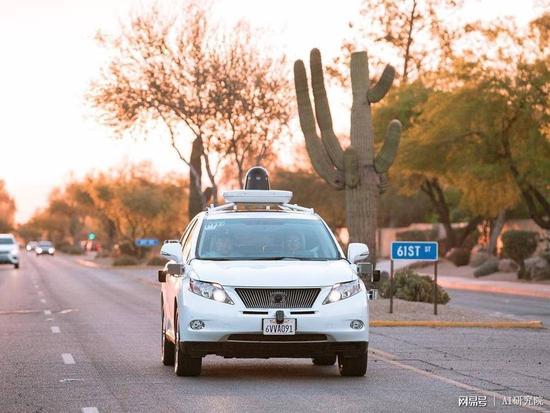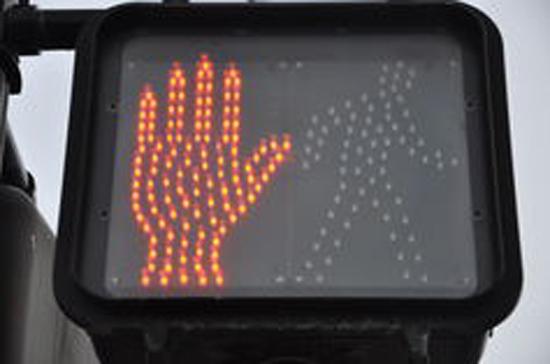
[Netease Smart News, August 28] As driverless cars begin to become fixed devices on the road, we must consider how to protect the safety of pedestrians. There are many ways we can choose, but the standard has not yet been set.
At present, there are two ways for pedestrians to cross the road safely: One is waiting until there is no car approaching, and there is enough time to cross the road in this case. The other way is to communicate with the oncoming driver. With the rise in the death toll of U.S. roadwalkers (a 25 percent increase since 2010 and a death toll of more than 5,000 in 2015), the arrival of driverless cars has promised to improve this tragic safety record.
Whether we are at a crosswalk, at a traffic light, or just in the middle of the road, we knew from an early age that it is important to make eye contact with people who drive. But this is impossible to achieve on driverless cars. Even if someone is sitting in the driver's seat, this person will be a passenger. There is little or no control over the behavior of the car. Moreover, this passenger may still be busy working, watching a movie, and falling asleep. He simply ignores the situation in front of the car.
People and cars need to communicate in other ways. At this point, there is no prevailing practice. My own research, as well as many technology companies, car manufacturers, and startups, are exploring the use of different types of visual signals to achieve this goal - similar to a driver waving towards a pedestrian on the street, or using the car's headlights to Send a signal to give way. The results prove that this is quite complicated.
Part of the problem is that when people realize that a driverless car is approaching, people will react: The Virginia Institute of Transportation Research Institute and the University of California, San Diego, scholars recently on a public road car In the news, the driver on the car was carefully disguised, and people thought that the car seemed to be unmanned (actually driven by people). A team of Duke University Human and Autonomous Laboratories is also studying how driverless cars will communicate with pedestrians.

A U.S. Standard "Stop Waiting" Signal
Although in the field of transportation today, the Federal Government has guidelines for pedestrian traffic lights, but there is no standard for vehicle-to-person communication. Setting standards in this area is very important: Setting up a common cross signal at the intersection of the country will make both pedestrians and drivers more secure. But we still don't know what works best.
Maybe it's setting the mark on the roof or the front bumper – or somewhere in between them – to set a lighted mark, but what does the mark say? Whether it needs to use multiple languages, or whether people should pass a standard non-text symbol, just like the symbols at the airport, so anyone can understand it. Or play a sound, or a piece of music? No matter what the mark looks like, it must be understood by people of all ages, education levels, and places.
On a two-lane road, setting a “safety-accessible†text phrase on a car should be feasible for a pedestrian. But there are many more complicated situations: For example, when you cross a four-lane road, can “safe passage†guarantee that there is no car in the other lane? When multiple pedestrians pass from both sides of the street, which car is safe to pass to them?
The appearance of these marks is also important. If information such as “safe to pass through†is to be clearly read at a height of 100 feet—this is our current standard for fixed cross-signals—the letters must be at least 6 inches high. This requires placing them on a screen that is nearly four feet wide. If the marker is to be set on a moving vehicle, the information card may need to be larger.
Of course, the mark is useless if no one sees it. This is a problem that we completed in a study that we completed last year. We compared the different types of displays in front of a van, and we disguised the vehicle as human-free. We found that only 12% of pedestrians use the display to help them decide when to cross the road. Most people rely on their past methods of crossing the street, such as assessing the speed and distance of oncoming vehicles to ensure they have time to walk through.
As the popularity of driving cars in humans decreases, laboratories like ours -- and laboratories in Virginia and California -- will continue to study pedestrian responses so that we can better ensure everyone's safety. These efforts mean that more people will encounter scientists disguised as car seat driving vehicles. (From: futurism Translation: Netease sees off the intelligent compiler robot: Wu Man)
This article is produced by NetEase Smart Studio (public number smartman 163). Focus on AI and read the next big era!
High efficient charging speed for Sony laptop, stable current outlet can offer power for the laptop at the same time charge the laptop battery. The best choice for your replacement adapter.We can meet your specific requirement of the products, like label design. The plug type is US/UK/AU/EU. The material of this product is PC+ABS. All condition of our product is 100% brand new.
Our products built with input/output overvoltage protection, input/output overcurrent protection, over temperature protection, over power protection and short circuit protection. You can send more details of this product, so that we can offer best service to you!
Adapter For Sony,Charger For Sony,Laptop Charger For Sony ,Sony Laptop Adapter
Shenzhen Waweis Technology Co., Ltd. , https://www.waweisasdapter.com
